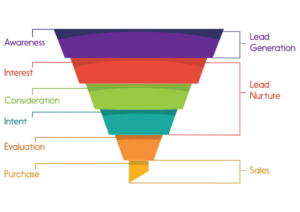With more than 80% of Grow NZ members listing marketing as one of your key priorities, we want to shine some light on a tried and tested marketing practice for attracting, engaging, converting and retaining customers: the sales and marketing funnel.
Before we get started, you might be thinking, why a ‘funnel’? Simply put, the inverted pyramid, or funnel shape, is used to show how your audience changes and becomes more focussed during the sales and marketing process. You start with a wide audience and then, as you articulate your brand, its values and value-adds, your audience becomes both more concentrated and valuable to you.
Taking the time to map out what the funnel looks like for your brand allows you to put yourself in your customers’ shoes and view your product or service from the outside. This is a great way to identify any gaps or areas for improvement in your business.
So, here we go. Below is the essential journey an individual must go through before you can convert them into a customer.

Generating a potential pool of customers
Awareness: This stage is all about getting your brand known by potential customers. You can do this in a range of ways including advertising, social media campaigns, trade shows, word of mouth and markets or search engine optimisation (SEO). Cast your net as wide as you like.
Nurturing your customer
Interest: Now your brand is out there, it’s time to make a bit of a song and dance about it. Create some interest and bring your brand and its values to life. It’s a good idea to offer some free, brand-relevant value to your customers, without pushing your product yet. Consider blogs, webinars, infographics, free e-books, newsletters, competitions or giveaways. Whatever you do, make sure your message is on brand and full of positive connotations towards your own product or service.
Consideration: It’s at this stage that your customers may start considering purchasing from you. Your job now is to convince them that your product or service is the answer to the problem they are trying to solve. And they need to understand why yours is better than any other solution available. Start showing off your unique sales proposition (USP). Customer feedback, surveys and focus groups will help you to understand what customers find most important about a certain product or service. If you’ve got sales professionals, this is their time to shine.
Evaluation: Having connected with your brand and product, a customer will at this point decide whether to buy from you. What’s important to point out is that the decision-maker won’t necessarily be the one purchasing or using the product. For example, a child may ask her parents for a new bike. Even though the child will be the user, it will be her parents deciding and purchasing on her behalf. So while the child needs to be targeted with how amazing the bike is, the parents need to be informed about how safe, durable and cost-effective it is.
Converting your customer (securing the sale)
Purchase: There are two good reasons the purchase step is separate from the Evaluation step.
1. As stated above, the user may not necessarily be the purchaser.
2. Despite having mentally decided to go ahead with the purchase, the sale could still be scuppered by poor point of sale execution. A purchaser could struggle to find your web-store or have issues with the payment options at the checkout. You need to make it as easy and enjoyable as possible to get the sale across the line. If your store is online, ditch any distracting features, like last-minute pop-ups, that could take buyers off their purchasing path.
Keep them coming back for more
Repeat: This step isn’t pictured on the funnel, but ignore it at your peril. In the competitive business environment in which we operate, keeping customers for as long as possible is the real game, so astute business owners will make earning a repeat purchase as important as securing the first sale. Customer experience and after-sales service are essential for building and maintaining a great relationship with your customer. Over-delivering on your service by adding some fanfare to your product, offering free value-adds in the form of useful emails or discounts, or asking customers for their valued opinion are all good ways of nurturing a long-term relationship.
So there you go. The sales and marketing funnel in a nutshell. While it might be tempting at times, skipping steps is never a good idea. A customer who is properly on-boarded with your brand is much more likely to boomerang. So remember, play the long game.


